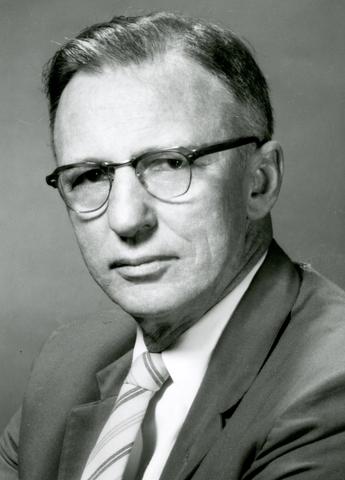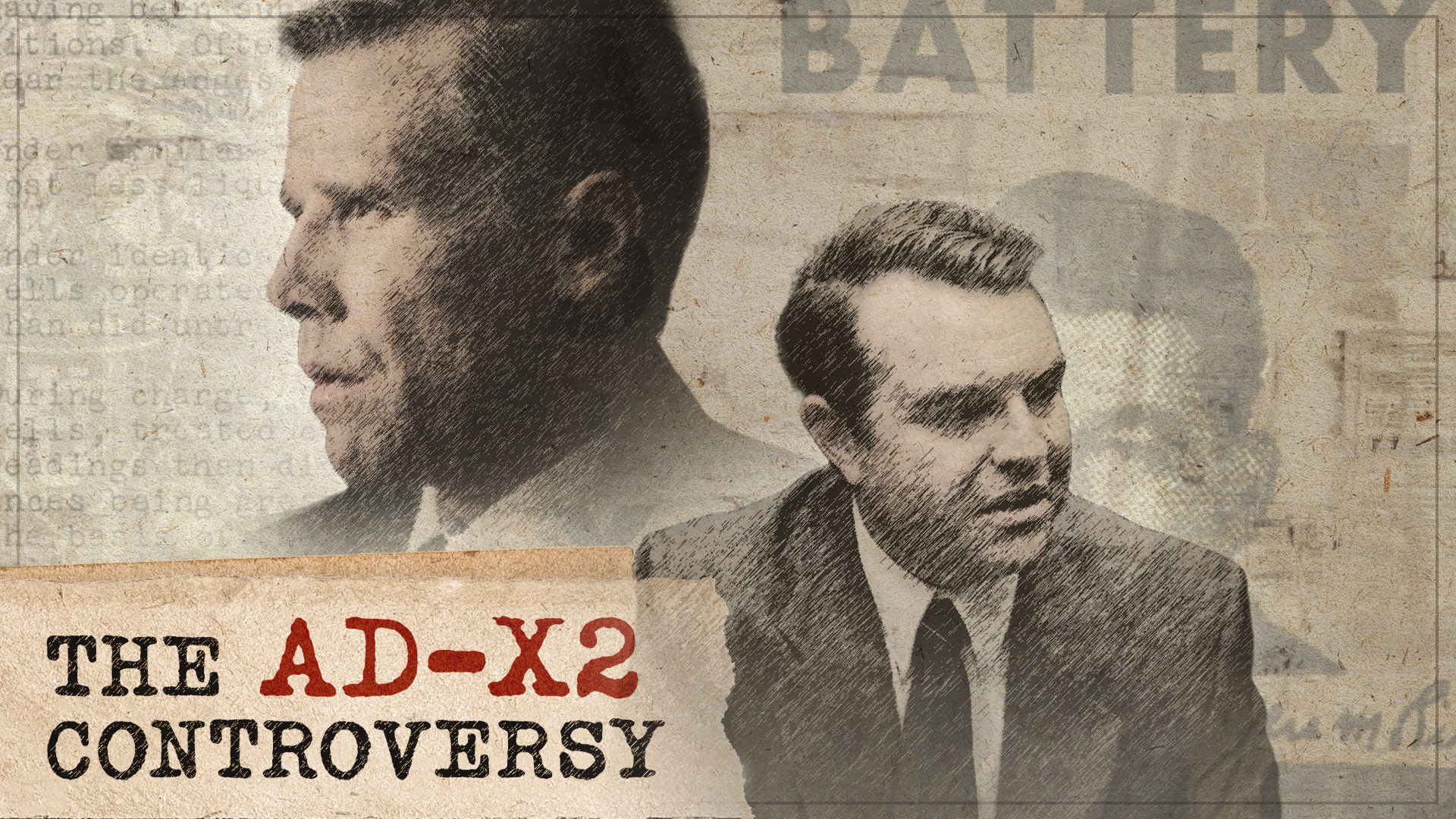Allen V. Astin: A Turning Point for the National Bureau of Standards

Allen Astin (June 12, 1904 – January 28, 1984) was director of NIST from 1951 until 1969.
by Jim Schooley, SAA History Committee
Political pressure is the bane of objective scientific work in any setting university, industry, or government. During its first fifty years, the National Bureau of Standards was relatively free of it. The NBS staff had established a reputation for patient, careful work, with scientific clarity and measurement accuracy its watchwords. As the end of its first half-century approached, however, the agency faced a serious threat to its well-earned reputation.
Allen V. Astin, newly placed as Bureau director, bore the brunt of the challenge, and he proved equal to the task. Allen Astin, the oldest of the three children of a school teacher in Utah, learned self-discipline early in life. His father died when Allen was only four years old; of necessity, his early years involved hard work and saving. However, he managed to put himself through the University of Utah physics program and in 1928 he was granted the Ph.D. degree in physics from New York University. In the same year, Astin obtained a two-year fellowship for studies at Johns Hopkins University. On completing the fellowship, he sought, and eventually obtained, a staff position at the National Bureau of Standards. There he progressed rapidly. His reserved but friendly personality, his steady growth as a scientist and, later, his leadership as chief of the Bureaus Electronics and Ordnance Division, led to his appointment in 1948 as associate director of NBS. Soon, he would play a central role in a bizarre incident that would test his character severely.
As part of a decades-long pursuit of stable voltage standards, the Bureau had tested batteries of many kinds, as well as a multitude of additives intended to prolong battery life. In fact, the staff of the NBS Electrochemistry Section, under the leadership of George Vinal since its founding in 1918, had even manufactured lead-acid batteries for a time in response to a request from the military. So it happened that in 1948, when a businessman from California, a Mr. Jess Ritchie, insisted that the Bureau test his battery additive which Mr. Ritchie called AD-X2the Bureau staff was well-versed on the subject.
Vinal corresponded at length with Mr. Ritchie, hoping to convince him to abandon his request for two reasons. First, NBS had a long-standing policy of testing individual commercial products only under unusual circumstances, such as a request by another government agency. Second, the components of AD-X2 (principally Epsom salts and Glauber's salts, sulfates of magnesium and sodium, respectively) were known by the Bureau staff to be ineffective in healing ailing batteries.
Alas, Mr. Ritchie turned to some satisfied customers, to a friendly university professor, and to U.S. Senator William F. Knowland to press NBS to test the value of AD-X2. Sen. Knowland did so during December, 1948, in a letter to Edward U. Condon, at that time the director of the Bureau. Condon responded to Sen. Knowland that, in view of Bureau policy and the similarity of AD-X2 to other ineffective battery additives, it did not seem desirable for NBS to test the product.
From that exchange, the AD-X2 testing issue expanded over a three-year period to include the participation of more than 20 U.S. senators. Generally unspoken during the correspondence was the difficulty of trying to prove a negative, in this case demonstrating unequivocally that any given additive would never save a failing battery.
On August 10, 1951, Condon, under heavy fire from the House Committee on Un-American Activities for his opposition to U.S. accumulation of nuclear weaponry, resigned his position as director of NBS. Condon found that he could no longer effectively represent the Bureaus programs to Congress because of the legislators preoccupation with his stance on disarmament.
As the fairness and accuracy of the NBS testing programs were called into question in a very public way by the U.S. Congress, President Harry Truman appointed Allen Astin to the position of Acting Director of the Bureau. During May, 1952, Astin was confirmed as NBS Director.
By 1953 the Federal Trade Commission, the U.S. Post Office, a Senate Select Committee on Small Business, the Massachusetts Institute of Technology, and the Catholic University of America all had become involved in the testing controversy in one way or another. Many tests of the effectiveness of AD-X2 as a battery additive were conducted at the behest of Congress, most prominently by NBS and by MIT. The NBS tests, performed with careful controls, uniformly showed no positive benefit from the additive (the MIT testers surprisingly reported finding AD-X2 to be effective in re-vitalizing certain batteries, but that conclusion was later denied by an MIT spokesman in testimony before Congress). Allen Astin participated fully in the discussions that accompanied the NBS testing, and he and George Vinal personally reviewed all of the Bureaus testing procedures over a two-year span of time.
The election of Dwight Eisenhower in 1952 brought the controversy to a head. The new president had made a campaign promise to get the government off the backs of Americas small businessmen. His new Department of Commerce team, Sinclair Weeks, the new Secretary of Commerce, and Craig Sheaffer, Weeks deputy in charge of NBS, were businessmen and they soon decided that NBS was guilty of unfairly besmirching the product of a small business. On March 24, 1953, Weeks and Sheaffer called Astin downtown and asked him to resign. Astin did so immediately, realizing that without the confidence of his superiors, he could accomplish nothing.
The Department of Commerce appeared to take no particular notice of Astin's resignation, considering it no different from the usual replacement of agency heads that accompanies any change in the national administration. Astin, said Weeks in a public comment, had been guilty of discounting entirely the play of the marketplace in its treatment of the product AD-X2. Weeks asked the NBS Visiting Committee to convene a panel to recommend changes in the Bureaus testing program that would make it more businesslike.
The blatantly political nature of Astin's firing led journalist Drew Pearson to write a scathing column, carried in the Washington Post and in some 300 other newspapers throughout the U.S. Pearson questioned vigorously whether politics should play a pivotal role in the testing programs of the National Bureau of Standards. The scientific community, led by the Federation of American Scientists and the American Physical Society, was also greatly aroused, and scientists and industrialists alike cried out against the politicization of an agency whose charter called for unbiased, science-based results. Nearly 400 Bureau staff members threatened to follow Astin out the door, an action that would have doomed several programs of national and military importance.
The NBS Visiting Committee demanded that Astin be reinstated while it pondered the fate of the Bureau. Since the committee members represented such August scientific bodies as the National Academy of Sciences and Bell Telephone Laboratories, Weeks acceded to its demand.
The nationwide uproar that accompanied Astin's removal from office evidently educated Secretary Weeks regarding the importance of scientific objectivity at NBS. Furthermore, Astin's calm but forceful demeanor throughout the ordeal, coupled with his reasoned and effective testimony before Congress on the NBS mission and its testing programs, evidently led Weeks to view Astin in a new light, as did the findings of a blue-ribbon panel headed by Mervin J. Kelly, president of Bell Telephone Laboratories. That panel, convened under the auspices of the NBS Visiting Committee to examine its testing programs, urged that NBS be the very best technical organization possible, because of America's need for accurate and objective measurement science.
On August 21, 1953, barely five months after demanding Astin's resignation, Weeks announced that Astin would remain as NBS director. During the balance of his service as Secretary of Commerce, Weeks strongly supported NBS and its programs.
The AD-X2 ordeal brought with it the threat that NBS would be forced to abandon its devotion to objective scientific fact and become instead a politicized agency. The insistence of the scientific staff of the Bureau that its traditional role be respected and the support of the national scientific establishment for that role proved essential in a very public battle. But leading the way was a quiet man who embodied the integrity of the agency in his bearing, his actions and his words.
Watch the NIST-produced documentary about AD-X2.
The main resource used for this note was the extensive discussion in Ch. 2 of Passaglia's history, A Unique Institution: The National Bureau of Standards, 1950-1969", NIST Special Publication 925. Voluminous material on the topic also is maintained in the NIST archives.
The NBS/NIST Culture of Excellence series is produced under the auspices of the Standards Alumni Association. The SAA, with offices in the basement of the Administration Building, supports NIST management in a variety of ways, but principally by assistance with historical projects such as oral histories of staff members, biographical files, the portrait gallery of outstanding employees, and the museum. Membership in SAA is open to all present and former employees of NIST. For information, call x2486.


